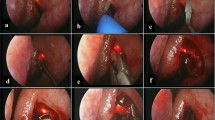Abstract
Aim
To evaluate the role of concomitant endonasal procedures in endocanalicular diode laser dacryocystorhinostomy (DCR).
Materials and methods
This was a retrospective study, conducted on adult patients with primary acquired nasolacrimal duct obstruction. Thirty-one (seven bilateral) patients formed group 1 and 37 (five bilateral) patients group 2. Group 1 underwent endocanalicular laser DCR. In group 2, concomitant endonasal procedures, namely middle turbinectomy and endonasal mechanical enlargement of the neo-ostium were additionally performed. Mean follow-up period was 14.6 months for group 1, and 11.0 for group 2.
Results
Functional success was defined as the absence of epiphora, and anatomical success as the ability to irrigate the lacrimal system. Anatomic and functional success at each visit were compared using chi-square tests (p < 0.05). Total laser energies used for each case were compared using the Mann–Whitney U test (p < 0.05). Anatomical success rates were increased at the third month, sixth month and final visits. The increase was statistically significant. P value was 0.04 for the third and sixth month results comparison. Final anatomical success rates were 27/38 for group 1 and 39/42 for group 2 (p = 0.02). Final functional success rates were 25/38 patients in group 1 and 36/42 in group 2 (p = 0.07). Mean total laser energy used decreased from 300.0 to 165.0 joules (p < 0.001).
Conclusions
Based on our increased anatomical success rates, concomitant endonasal procedures may help increase success rate in endocanalicular diode laser DCR cases.





Similar content being viewed by others
References
Tarbet KJ, Custer PL (1995) External dacryocystorhinostomy. Surgical success, patient satisfaction, and economic cost. Ophthalmology 102:1065–1070
Wormald PJ, Kew J, Van Hasselt A (2000) Intranasal anatomy of the nasolacrimal sac in endoscopic dacryocystorhinostomy. Otolaryngol Head Neck Surg 123:307–310
Ben Simon GJ, Joseph J, Lee S, Schwarcz RM, McCann JD, Goldberg RA (2005) External versus endoscopic dacryocystorhinostomy for acquired nasolacrimal duct obstruction in a tertiary referral center. Ophthalmology 112:1463–1468
Ibrahim HA, Batterbury M, Banhegyi G, McGalliard J (2001) Endonasal laser dacryocystorhinostomy and external dacryocystorhinostomy outcome profile in a general ophthalmic service unit: a comparative retrospective study. Ophthalmic Surg Lasers 32:220–227
Tsirbas A, Davis G, Wormald PJ (2005) Revision dacryocystorhinostomy: a comparison of endoscopic and external techniques. Am J Rhinol 19:322–325
Gurler B, San I (2004) Long-term follow-up outcomes of nonlaser intranasal endoscopic dacryocystorhinostomy: how suitable and useful are conventional surgical instruments? Eur J Ophthalmol 14:453–460
Unlu HH, Toprak B, Aslan A, Guler C (2002) Comparison of surgical outcomes in primary endoscopic dacryocystorhinostomy with and without silicone intubation. Ann Otol Rhinol Laryngol 111:704–709
Tsirbas A, Wormald PJ (2003) Mechanical endonasal dacryocystorhinostomy with mucosal flaps. Br J Ophthalmol 87:43–47
Selig YK, Biesman BS, Rebeiz EE (2000) Topical application of mitomycin-C in endoscopic dacryocystorhinostomy. Am J Rhinol 14:205–207
Fayet B, Racy E, Assouline M (2002) Systematic unciformectomy for a standardized endonasal dacryocystorhinostomy. Ophthalmology 109:530–536
Athanasiov PA, Prabhakaran VC, Mannor G, Woog JJ, Selva D (2009) Transcanalicular approach to adult lacrimal duct obstruction: a review of instruments and methods. Ophthalmic Surg Lasers Imaging 40:149–159
Hong JE, Hatton MP, Leib ML, Fay AM (2005) Endocanalicular laser dacryocystorhinostomy. Analysis of 118 consecutive surgeries. Ophthalmology 112:1629–1633
Henson RD, Henson RG Jr, Cruz HL Jr, Camara JG (2007) Use of the diode laser with intraoperative mitomycin C in endocanalicular laser dacryocystorhinostomy. Ophthalmic Plast Reconstr Surg 23:134–137
Plaza G, Beteré F, Nogueira A (2007) Transcanalicular dacryocystorhinostomy with diode laser: long-term results. Ophthalmic Plast Reconstr Surg 23:179–182
Rosen N, Barak A, Rosner M (1997) Transcanalicular laser-assisted dacryocystorhinostomy. Ophthalmic Surg Lasers 28:723–726
Mirza S, Jones N (2007) Laser-assisted dacryocystorhinostomy. In: Weber RK, Keerl R, Schaefer SD (eds) Atlas of lacrimal surgery. Springer-Verlag, Berlin, Heidelberg, pp 73–85
Michael N, Sebastian S, Matthew WY (2004) Concomitant nasal procedures in endoscopic dacryocystorhinostomy. J Laryngol Otol 118:267–269
Lee HY, Kim CH, Kim JY, Kim JK, Song MH, Yang HJ, Kim KS, Chung IH, Lee JG, Yoon JH (2006) Surgical anatomy of the middle turbinate. Clin Anat 19:493–496
Lee JJ, Woo KI, Kim YD (1997) Middle turbinectomy during dacryocystorhinostomy. J Korean Ophthalmol Soc 38:710–714
Havas TE, Lowinger DS (2000) Comparison of functional endonasal sinus surgery with and without partial middle turbinate resection. Ann Otol Rhinol Laryngol 109:634–640
Banfield GK, McCombe A (1999) Partial resection of the middle turbinate at functional endoscopic sinus surgery. J R Army Med Corps 145:18–19
Brescia G, Pavin A, Giacomelli L, Boninsegna M, Florio A, Marioni G (2008) Partial middle turbinectomy during endoscopic sinus surgery for extended sinonasal polyposis: short- and mid-term outcomes. Acta Otolaryngologica 128:73–77
Vleming M, Middelweerd RJ, de Vries N (1992) Complications of endoscopic sinus surgery. Arch Otolaryngol Head Neck Surg 118:617–623, Review
Biedlingmaier JF (1993) Endoscopic sinus surgery with middle turbinate resection: results and complications. Ear Nose Throat J 72:351–355
Shih C, Chin G, Rice DH (2003) Middle turbinate resection: impact on outcomes in endoscopic sinus surgery. Ear Nose Throat J 82:796–797
Hong-Ryul J, Je-Yeob Y, Mi-Young C (2006) Endoscopic dacryocystorhinostomy: creation of a large marsupialized lacrimal sac. J Korean Med Sci 21:719–723
Declaration of interest
This study was supported by Eskişehir Osmangazi University Scientific Research Project (Project number: 200811037) Commission.
Author information
Authors and Affiliations
Corresponding author
Additional information
All the authors have full control of all primary data, and agree to allow Graefe's Archive for Clinical and Experimental Ophthalmology to review their data upon request.
Rights and permissions
About this article
Cite this article
Basmak, H., Caklı, H., Sahin, A. et al. Comparison of endocanalicular laser dacryocystorhinostomy with and without endonasal procedures. Graefes Arch Clin Exp Ophthalmol 249, 737–743 (2011). https://doi.org/10.1007/s00417-010-1552-1
Received:
Revised:
Accepted:
Published:
Issue Date:
DOI: https://doi.org/10.1007/s00417-010-1552-1




